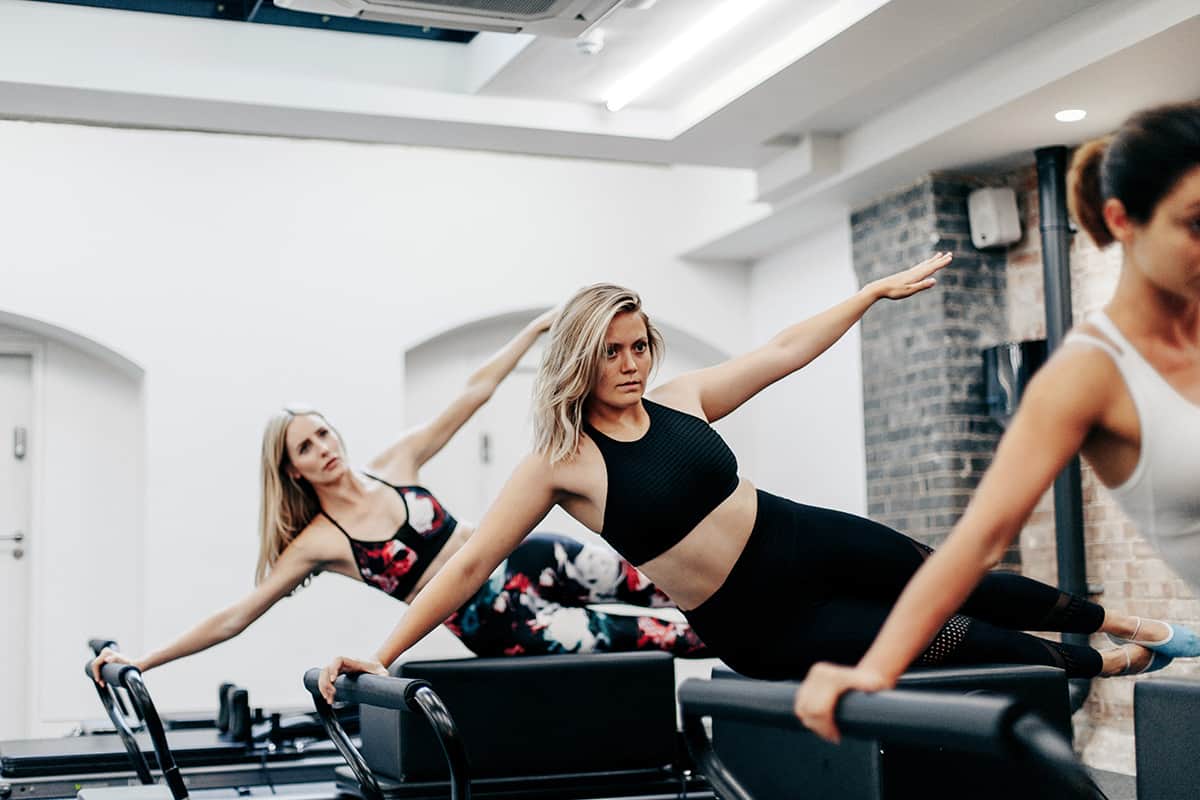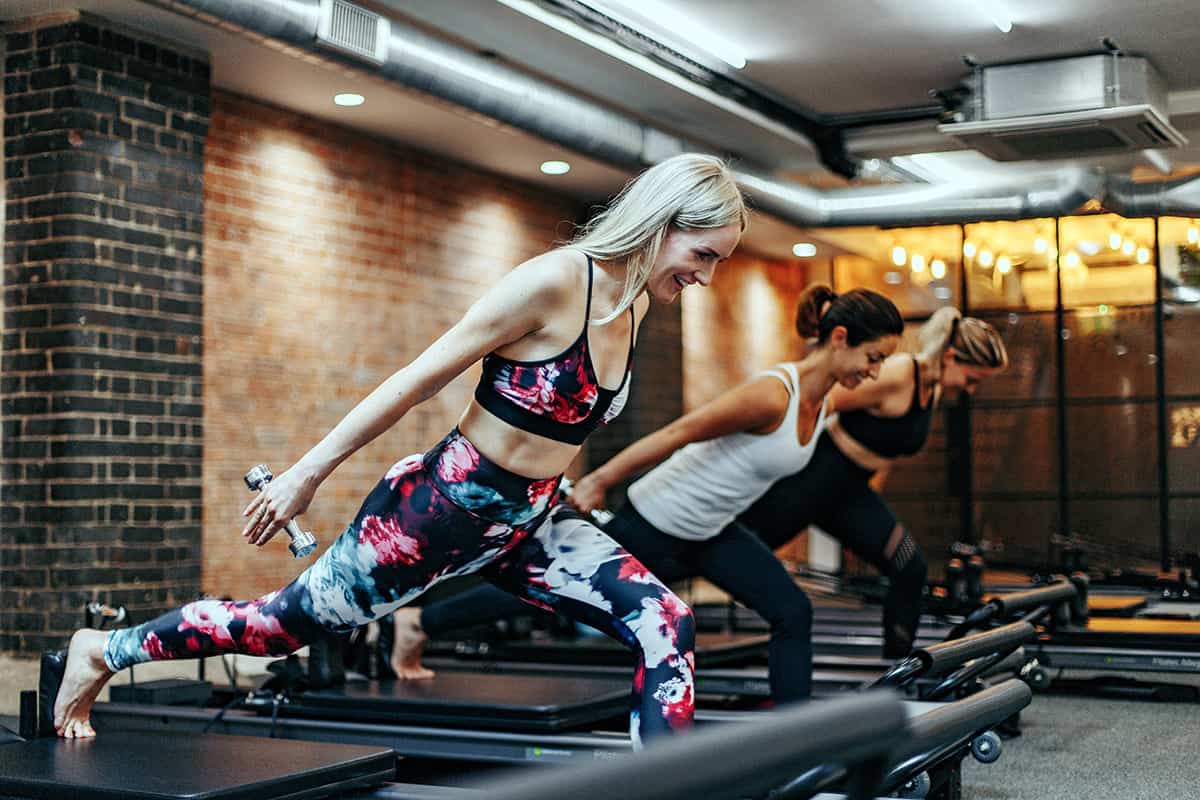Are you sitting down? Here’s the bad news, it’s ‘the new smoking’ according to health experts, who have linked the overly sedentary lifestyle of the average office worker with being overweight and obese, Type 2 diabetes, some types of cancer, and early death.
It’s certainly true that human beings weren’t built to sit, but assuming those emails won’t write themselves, we have to find new ways to combat the effects of long hours hunched over laptops and lunches consumed al desko.
Pilates has long been touted as the miracle cure for posture and flexibility, helping restore our natural spinal alignment and creating a strong core to support the back and reduce the chance of injury.

And when a workout promises to reverse the impact of all that time spent parked on our backsides (and tone them in the process), we’re prepared to overlook the fact that it is carried out on what looks like some sort of torture device.
What is it?
Reformer Pilates is performed on a long, low piece of equipment with a platform at one end and a sliding carriage upon which you sit, stand, lie and kneel and perform a series of controlled movements using adjustable springs and straps to regulate tension and resistance.
It looks a bit like a narrow single bed frame, but don’t expect to nap your way through the classes at Ten Health & Fitness, which they describe as “Pilates, with bite”.
How does it work?
Pilates is a series of exercises originally created by Joseph Pilates (1883-1967) to develop strength, mobility, core control, alignment and postural awareness
Ten Health’s Dynamic Reformer workouts are a more intense version of classic Pilates moves as they incorporate more functional exercises linked by a continuous ‘flow’ to keep your heart rate up. “We’ve updated a lot of the traditional movements that were designed by Joseph Pilates with full-body integrated exercises so you might be working your arms, glutes and core at the same time,” explains Elle Rich, a physiotherapist and manager at Ten Health’s City studio.

“Rather than isolating certain muscle groups, we’ve found that integrating the movements make them more applicable to our day-to-day life.
“You wouldn’t just use a left glute or right glute when you squat down to pick up something, and that’s why functional training is so important.”
These integrated moves range from a series of plank press ups – sliding the carriage away from the footbar and sinking down to hover above the platform – to the positively murderous ‘skater’; balancing one foot on the platform and sliding the carriage away with the other while doing tricep kickbacks with 2kg to 3kg hand weights.
Every exercise targets a certain group of muscles, with between 12 and 15 repetitions for each. Most of these are slow, controlled movements, but there are some pulses and static holds at the end to up the intensity. Elle also provides much more advanced options to increase resistance using different springs or decrease stability by holding poses for longer, or adding arms to the leg sequence.
Your core is constantly working to keep you from rolling off the carriage; even standing on the carriage engages your pelvic floor.
Start with a beginner class, then progress to intermediate and advanced levels. Elle recommends between two and three sessions per week if you want to see results fast.
What are the benefits?
A simpler question to answer might be ‘what aren’t the benefits?’
First there’s the toning and sculpting; Pilates’ slow, controlled movements put you on the fast-track to long, lean muscles and a trim, taught midsection.

Building muscle mass also increases your metabolism, so even though you might not be sweating through a HIIT class, you’re still burning fat.
Plenty of clients report feeling as though they are walking taller – that’s the improvement in core strength which helps you to stand up straighter and aids your overall posture – and the controlled movements help increase your balance and co-ordination.
Elle says that by moving on multiple planes of motion, you are reversing some of the effects of an overly sedentary lifestyle.
“Sitting down and hunching over a desk, people will often develop tight hamstrings and hip flexors, their shoulders might pop forward and you get a rounded upper back… but all these moves have been designed to get those muscles moving dynamically in a safe and sustainable way.”
The same goes for those looking to improve their performance in other sports: “If you’re running or swimming, there are certain parts of the body that are going to get overworked by this constant repetitive action.
“It’s why marathon runners at the beginning of their training might be able to touch their toes but then find as they progress their hamstrings and quads have shortened – Pilates is great for keeping those muscles long and maintaining your flexibility.”
How much?
First timers can try a class for £15. Thereafter, single classes are £30 but are cheaper if bought in bulk – a block of 10 classes is £230, while 30 is £600. There are also monthly and annual memberships on offer at a reduced rate for individuals and corporates.
Where can I try it?
Ten Health & Fitness City, 119-121 Middlesex Street E1 7JF or Ten Health & Fitness Hatton Garden, Lower Ground Floor, 36-38 Hatton Garden EC1N 8EB







